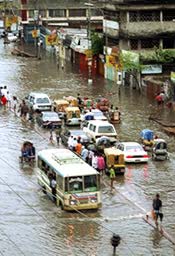Floods forecast for Bangladesh

Better flood forecasting could save lives in Bangladesh. <br>© AP/Abu Taher Khokon
With a weather monitoring network a new model could predict coastal floods in Bangladesh.
A new model should help forecast the massive floods to which the northern coast of Bangladesh is prone1. In principle, the model can predict the heights and arrival times of the huge waves that cyclones cause, and so could improve the planning of sea defences.
The effectiveness of the model will depend on the availability of accurate, timely and detailed meteorological data, cautions Bangladeshi scientist Junaid Amin As-Salek. He has spent six years in Japan with Takashi Yasuda of Gifu University developing the mathematical picture of the interactions between Bangladesh’s ocean, atmosphere and shoreline.
Gathering input data remains a formidable challenge. The technology for a weather-monitoring network exists, says As-Salek, who is now at the Great Lakes Environmental Research Laboratory in Michigan, USA. But a shortage of funding hampers its use in Bangladesh.
Bangladesh’s coast is in constant danger of devastating floods. Tropical hurricanes in the Indian Ocean move towards the coast, pushing a wall of water ahead of them. This creates a great wave called a storm surge, which can reach 12 meters high. In 1970, a five-metre wave flooded a million acres of rice fields, killing at least 200,000 people. More than 100,000 further lives were lost this way in 1991.
The country is densely populated and lacks the resources to erect defences or carry out evacuations. Also, the land is so low that even flood waves a couple of metres high can have terrible consequences.
Making waves
A coastal wave can have different effects at different times and places, making flooding hard to predict. As-Salek and Yasuda focused on the estuary of the Meghna River in the north of the Bay of Bengal – the region generally hit hardest by storm surges.
Their model provides a framework for predicting specific floods. It takes into account how coastal winds, the shape of the estuary, and the ebb and flow of the local tides affect a storm surge. A surge that coincides with a high tide, for example, is much more destructive. The estuary can also have a funnelling effect that accentuates flooding, As-Salek says.
The model could also help in planning permanent sea defences. At present, defences in Bangladesh are “very scattered and inadequate”, says As-Salek who feels they were not based on scientific predictions.
Coastal engineering relies on estimates of the ’design cyclone’: the hypothetical hurricane that generates the flood wave with the largest water volume at a particular point. As-Salek hopes his model will help make these calculations, putting sea defences on a rational footing. Whether sufficient resources will be available to implement such planning is another matter.
References
- As-Salek, J. A. & Yasuda, T. Tide-surge interaction in the Meghna estuary: most severe conditions. Journal of Physical Oceanography, 31, 3059 – 3072, (2001).
Media Contact
All latest news from the category: Earth Sciences
Earth Sciences (also referred to as Geosciences), which deals with basic issues surrounding our planet, plays a vital role in the area of energy and raw materials supply.
Earth Sciences comprises subjects such as geology, geography, geological informatics, paleontology, mineralogy, petrography, crystallography, geophysics, geodesy, glaciology, cartography, photogrammetry, meteorology and seismology, early-warning systems, earthquake research and polar research.
Newest articles

Sea slugs inspire highly stretchable biomedical sensor
USC Viterbi School of Engineering researcher Hangbo Zhao presents findings on highly stretchable and customizable microneedles for application in fields including neuroscience, tissue engineering, and wearable bioelectronics. The revolution in…

Twisting and binding matter waves with photons in a cavity
Precisely measuring the energy states of individual atoms has been a historical challenge for physicists due to atomic recoil. When an atom interacts with a photon, the atom “recoils” in…

Nanotubes, nanoparticles, and antibodies detect tiny amounts of fentanyl
New sensor is six orders of magnitude more sensitive than the next best thing. A research team at Pitt led by Alexander Star, a chemistry professor in the Kenneth P. Dietrich…





















